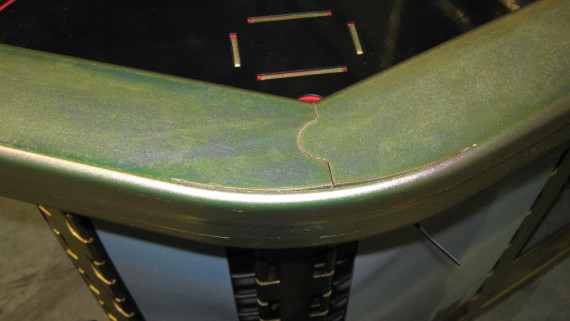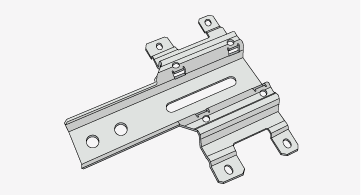Sheet metal design guidelines are followed to design quality sheet metal enclosures. This helps in delivering the product at low cost and faster timelines. All
- Sheet Metal Tab And Slot Design Guide Free
- Sheet Metal Tab And Slot Design Guidelines
- Sheet Metal Tab And Slot Design Guide Pdf
- Sheet Metal And Tab Slot Design Guide
- Sheet Metal Tab And Slot Design Guide Template
When designing for slots and tabs, never design for the tabs to be centered in the slot in regards to the material thickness. You always want tabs to be clamped against the inside of a slot to act as a stop. My experiences were normally 18-10ga sheet aluminum and SST, and 1/4'-1/2' plate steel. Although the Tab and Slot command is found in the pulldown menu INSERT SHEET METAL TAB AND SLOT, it is not a command limited to sheet metal type parts. Tab and slot can be applied to any part file type, which makes it incredibly valuable for woodworking type projects.

Sheet Metal Tab And Slot Design Guide Free
Sheet Metal Design Guidelines
Following points should be considered during the design of sheet metal parts for press bending.
Sheet Metal Material Selection
- Simulation Studies
- Past Experience
- Reverse Engineer existing products
- Experimental Studies
Read this guide to know more about sheet metal material selection Process.
Minimum inside bend Radius for Sheet Metal Parts
Sharp inside bend radius in sheetmetal parts can cause material flow problems in soft material and fracturing in hard material. Which results in localized necking or fracture. Therefore sharp bend radius is not recommended in sheet metal parts.
Bend radius throughout the sheet metal part is kept constant to take the advantage of using the same tool during manufacturing.
Sheet Metal Tab And Slot Design Guidelines
Minimum Sheet Metal Bend Length Recommendations

Minimum Hole Diameter Guidelines
Hole/Slot Distance from Bend Edge
Minimum distance between hole/slot edge to bend edge is recommended to avoid metal distortion, deformation and fracturing.
Center to Center Distance Between two Holes
Minimum center to center distance between two holes in sheet metal parts is required to avoid metal distortion, deformation and fracturing.
Recommended Minimum distance between two hole centers in sheet metal design should be equal to sum of hole radius plus two times the sheet thickness.
Recommended Distance = Radius of Hole1 + Radius of Hole2 + Sheet ThicknessEffect of Grain Direction in Sheet Metal Bending
During sheet metal processing ( rolling operation), material grains are arranged in the direction of rolling. When Sheetmetal is bend perpendicular to rolling direction grain rearranges. That has negligible impact on part strength. Whereas bending parallel to rolling direction can lead to cracks because of destruction in grain structure.
Bend Relief in Sheet Metal Bend
Bend relief is provided at the end of the bending edge in sheet metal design to avoid any crack tearing in the corner. Relief height is generally kept greater than two times of sheet thickness plus bend radius.
Extrude Hole Size and Position Guidelines
Creating an extruded hole using a punching process requires extreme pressure/Force. Extruded holes very close to the part edge can lead to sheet metal deformation or tearing. Therefore the minimum distance between the extruded hole to edge if maintained.
Extruded hole to part edge (B) = 3T + D/2Center of extruded Holes (A) = (5 + Hole Dia + 2T)Sheet Metal Tab And Slot Design Guide Pdf
Extruded Hole and bend edge (C) = 3T + R + D/2Round Emboss Design Guidelines
Creating Emboss feature using sheet metal punching requires extreme pressure. Very close emboss to the part edge, can lead to deformation in the sheet metal part.
A – Distance From Emboss To part Edge = 3T + D/2B- Distance Between Two Emboss = (5 + D)C- Distance between Emboss and Sheet Metal bend = 3T + R + D/2
Dimple Feature Design in Sheet Metal Parts
Louver Feature Design in Sheet Metal
Minimum distance between louver feature and bending edge is maintained to avoid metal deformation.
(P1) Distance Between Two lowers on Shorter Edge = 5 mm(P2) Distance Between Two lowers on Longer Edge = 8 mmRound Knockout Design Recommendation
(P1) Distance Between Two knockout = (5 + D) mmSheet Metal And Tab Slot Design Guide

Sheet Metal Tab And Slot Design Guide Free
Sheet Metal Design Guidelines
Following points should be considered during the design of sheet metal parts for press bending.
Sheet Metal Material Selection
- Simulation Studies
- Past Experience
- Reverse Engineer existing products
- Experimental Studies
Read this guide to know more about sheet metal material selection Process.
Minimum inside bend Radius for Sheet Metal Parts
Sharp inside bend radius in sheetmetal parts can cause material flow problems in soft material and fracturing in hard material. Which results in localized necking or fracture. Therefore sharp bend radius is not recommended in sheet metal parts.
Bend radius throughout the sheet metal part is kept constant to take the advantage of using the same tool during manufacturing.
Sheet Metal Tab And Slot Design Guidelines
Minimum Sheet Metal Bend Length Recommendations
Minimum Sheet Metal Flange Bend Length = 3 x Sheet Thickness + Bend RadiusMinimum Hole Diameter Guidelines
Hole/Slot Distance from Bend Edge
Minimum distance between hole/slot edge to bend edge is recommended to avoid metal distortion, deformation and fracturing.
Center to Center Distance Between two Holes
Minimum center to center distance between two holes in sheet metal parts is required to avoid metal distortion, deformation and fracturing.
Recommended Minimum distance between two hole centers in sheet metal design should be equal to sum of hole radius plus two times the sheet thickness.
Recommended Distance = Radius of Hole1 + Radius of Hole2 + Sheet ThicknessEffect of Grain Direction in Sheet Metal Bending
During sheet metal processing ( rolling operation), material grains are arranged in the direction of rolling. When Sheetmetal is bend perpendicular to rolling direction grain rearranges. That has negligible impact on part strength. Whereas bending parallel to rolling direction can lead to cracks because of destruction in grain structure.
Bend Relief in Sheet Metal Bend
Bend relief is provided at the end of the bending edge in sheet metal design to avoid any crack tearing in the corner. Relief height is generally kept greater than two times of sheet thickness plus bend radius.
Extrude Hole Size and Position Guidelines
Creating an extruded hole using a punching process requires extreme pressure/Force. Extruded holes very close to the part edge can lead to sheet metal deformation or tearing. Therefore the minimum distance between the extruded hole to edge if maintained.
Extruded hole to part edge (B) = 3T + D/2Center of extruded Holes (A) = (5 + Hole Dia + 2T)Sheet Metal Tab And Slot Design Guide Pdf
Extruded Hole and bend edge (C) = 3T + R + D/2Round Emboss Design Guidelines
Creating Emboss feature using sheet metal punching requires extreme pressure. Very close emboss to the part edge, can lead to deformation in the sheet metal part.
A – Distance From Emboss To part Edge = 3T + D/2B- Distance Between Two Emboss = (5 + D)C- Distance between Emboss and Sheet Metal bend = 3T + R + D/2Dimple Feature Design in Sheet Metal Parts
Louver Feature Design in Sheet Metal
Minimum distance between louver feature and bending edge is maintained to avoid metal deformation.
(P1) Distance Between Two lowers on Shorter Edge = 5 mm(P2) Distance Between Two lowers on Longer Edge = 8 mm